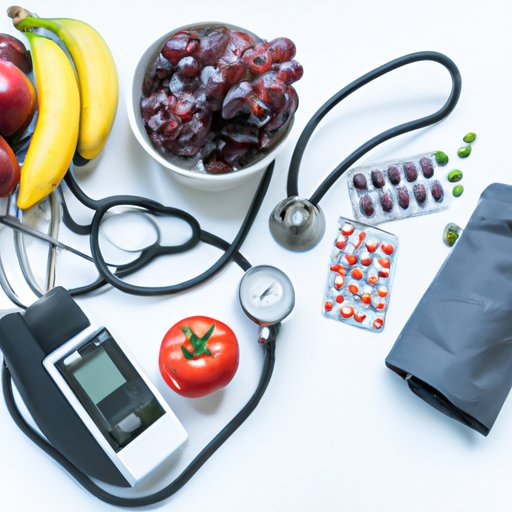
I. Introduction
High blood pressure is a common problem that affects millions of people worldwide. Managing blood pressure usually involves medication, but it’s important to know that there are natural ways to control blood pressure. A healthy lifestyle that includes diet, exercise, stress management, natural remedies, and monitoring levels can significantly help manage blood pressure without medication.
II. Focus on a healthy diet
A balanced and healthy diet is crucial to managing blood pressure levels. A healthy diet can help maintain weight, reduce cholesterol levels, and improve overall health, all of which can help improve blood pressure. Here are some tips for maintaining a healthy diet:
- Reducing salt intake: High salt intake is known to increase blood pressure. Reducing salt in the diet can help control blood pressure levels.
- Increasing fruits and vegetables: Eating fruits and vegetables can help bring blood pressure to a healthy level. They are rich in potassium, a mineral that helps regulate blood pressure.
- Drinking plenty of water: Drinking water is essential for body function. It helps flush out excess sodium, which can cause high blood pressure.
Some specific foods that are beneficial for blood pressure include:
- Leafy greens like spinach and kale
- Berries like blueberries and strawberries
- Bananas
- Tomatoes
- Fatty fish like salmon and tuna
- Oatmeal
III. The importance of exercise
Physical activity is one of the most effective ways to control blood pressure levels. Exercise can also help maintain a healthy weight, reduce stress, and improve overall health. Here are some tips for exercising to help control blood pressure:
- Strength training: Strength training exercises can help reduce blood pressure levels. Lifting weights, using resistance bands or even doing bodyweight exercises can help.
- Aerobic activity: Aerobic exercise like walking, jogging, or cycling can help lower blood pressure and keep it in a healthy range.
- Duration and frequency: Aim for at least 30 minutes of exercise most days of the week. However, even small amounts of exercise can be beneficial.
Some specific exercises that are beneficial for blood pressure include:
- Brisk walking
- Cycling
- Swimming
- Dancing
- Yoga
IV. Stress management techniques
Stress is known to have a significant impact on blood pressure levels. Managing stress can help control blood pressure and improve overall health. Here are some stress management techniques that can be helpful:
- Yoga: Yoga can help reduce blood pressure by promoting relaxation and reducing stress.
- Mindfulness: Mindfulness helps manage stress by focusing on the present moment and reducing anxiety.
- Meditation: Meditation can help reduce blood pressure by promoting relaxation and calming the mind.
- Other stress-reducing activities: Activities such as spending time with family and friends, listening to music, or pursuing a hobby can help reduce stress levels.
V. Natural remedies
Supplements and lifestyle adjustments can help manage blood pressure levels naturally. Here are some natural remedies that can help:
- Magnesium: Magnesium can help reduce blood pressure levels by relaxing blood vessels.
- Potassium: Potassium can help control blood pressure levels by promoting the excretion of sodium.
- CoQ10: CoQ10 can help lower blood pressure levels and promote optimal heart health.
- Avoiding alcohol: Drinking too much alcohol can increase blood pressure levels. It’s important to limit alcohol intake for better blood pressure control.
- Quitting smoking: Smoking can damage blood vessels and increase the risk of high blood pressure. Quitting smoking can improve overall health and lower blood pressure.
VI. Monitoring blood pressure levels
Regularly monitoring blood pressure levels is essential to control blood pressure effectively. Here are some ways to monitor blood pressure levels:
- At-home blood pressure monitoring devices: At-home blood pressure monitoring devices can be used to measure blood pressure levels regularly.
- Regular visits to the doctor to track progress: Consulting with the doctor regularly to track progress is an essential part of managing blood pressure naturally.
It’s important to work with a healthcare provider to create a personalized plan for managing blood pressure levels naturally.
VII. Conclusion
Managing blood pressure naturally through diet, exercise, stress management, natural remedies, and monitoring levels is possible. By following these strategies consistently, you can reduce the risk of high blood pressure and maintain a healthy lifestyle. Remember to seek medical advice and work with a healthcare provider to create a personalized plan. Taking charge of your health through natural approaches is a great step towards achieving optimal wellness.




